Maximum Supertweeter


Enter the realm of musical revelation as we introduce the Townshend Maximum Supertweeter
Prepare to elevate your listening experience with the Townshend Maximum Supertweeter, where extraordinary sound quality meets cutting-edge technology. Designed to extend your system’s frequency range into the ultra-high frequencies, this revolutionary supertweeter brings out details you’ve never heard before, adding new dimensions to your music. The result? Enhanced spatial clarity, improved bass perception, and a richer, more immersive soundstage that will transform how you experience your favorite tracks. Whether you’re a seasoned audiophile or a casual listener, you’re in for a treat—because this is what true audio excellence sounds like.




Maximum Supertweeters
£1,693.00
At the heart of our innovation is the Townshend Seismic Isolation Podium, a breakthrough in vibration control that works from an impressive 3Hz by floating the equipment throughout the audio wave band. Unlike conventional rigid couplers that begin to isolate from around 14Hz, our Seismic Isolation system provides a more natural, less analytical sound, allowing you to enjoy music as it was meant to be heard.
Description
Since the late 1940s, when the term “hi fi” was first applied to high-quality (high fidelity) sound reproduction systems, it has been conventionally accepted that the range of human hearing has an upper limit of about 15 to 20 kHz.
The signal used to measure this response is an artificially‐generated sine wave. However, modern research and long term experience working with High Fidelity systems now question this firmly held belief. Harmonically rich, highly transient, real‐life sounds extend well beyond 20 kHz; for example, the muted trumpet has a frequency response extending to beyond 100 kHz.
Additional information
| Weight | 1.2 kg |
|---|---|
| Dimensions | 30 × 20 × 6 cm |
| Finish | Satin Black, Matt Silver |
Only logged in customers who have purchased this product may leave a review.
Related products
-

Allegri +
£3,199.00 Add to cart -

Seismic Platform
£809.00 – £936.00Price range: £809.00 through £936.00 Select options This product has multiple variants. The options may be chosen on the product page
Maximum SuperTweeters
BREATH LIFE INTO YOUR MUSIC
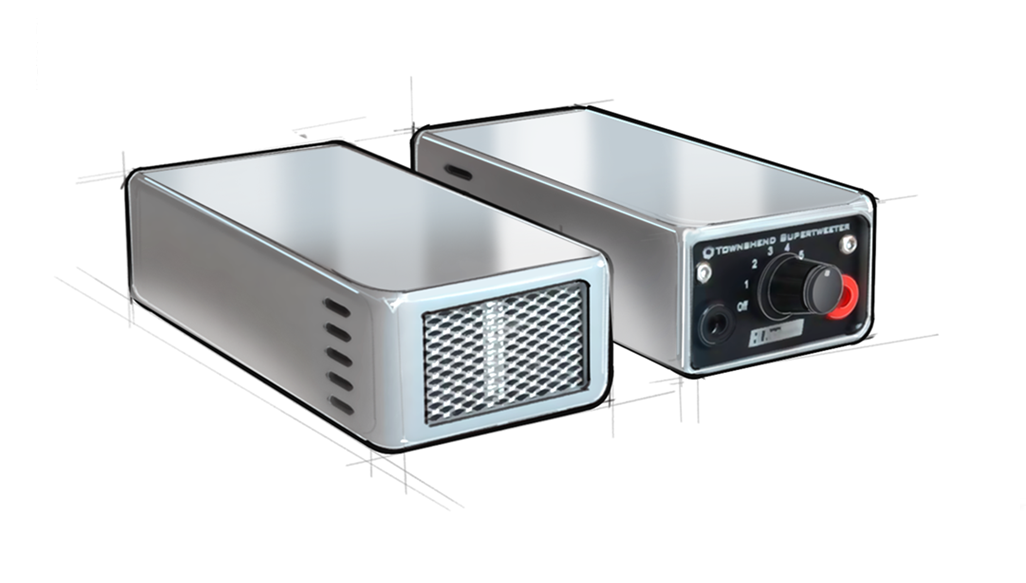
Why Super Tweeters?
Super tweeters are a pivotal component in the realm of high-fidelity audio, delivering an unparalleled listening experience. These specialized speaker drivers are meticulously engineered to produce ultra-high frequencies, venturing into the remarkable range of 20 kHz and beyond – frequencies that extend far beyond the scope of ordinary tweeters.
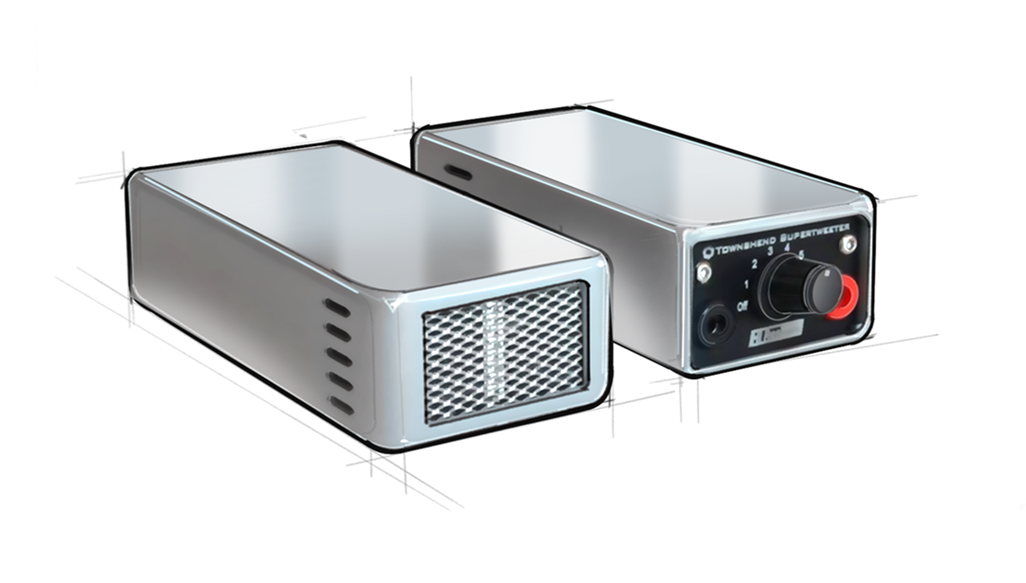
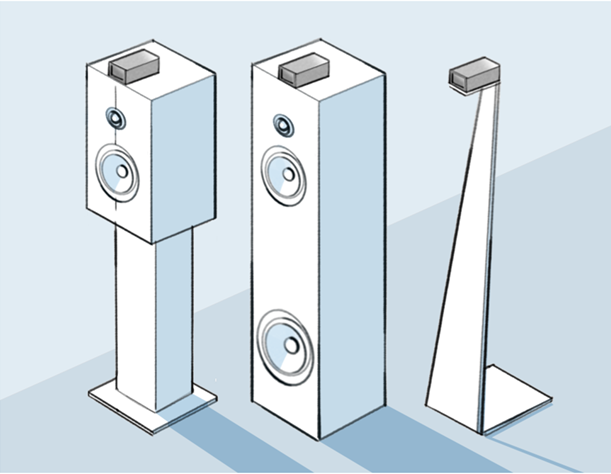
Why super tweeters?
Since the late 1940s, when the term “hi fi” was first applied to high-quality (high fidelity) sound reproduction systems, it has been conventionally accepted that the range of human hearing has an upper limit of about 15 to 20 kHz.
The signal used to measure this response is an artificially‐generated sine wave. However, modern research and long term experience working with High Fidelity systems now question this firmly held belief. Harmonically rich, highly transient, real‐life sounds extend well beyond 20 kHz; for example, the muted trumpet has a frequency response extending to beyond 100 kHz.
What people say
Technical Specification
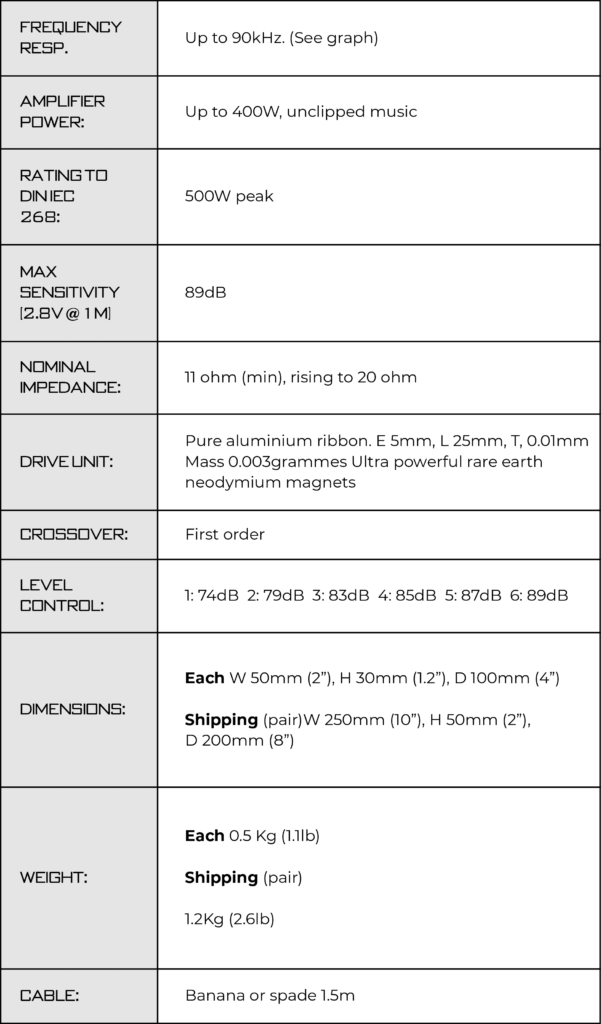
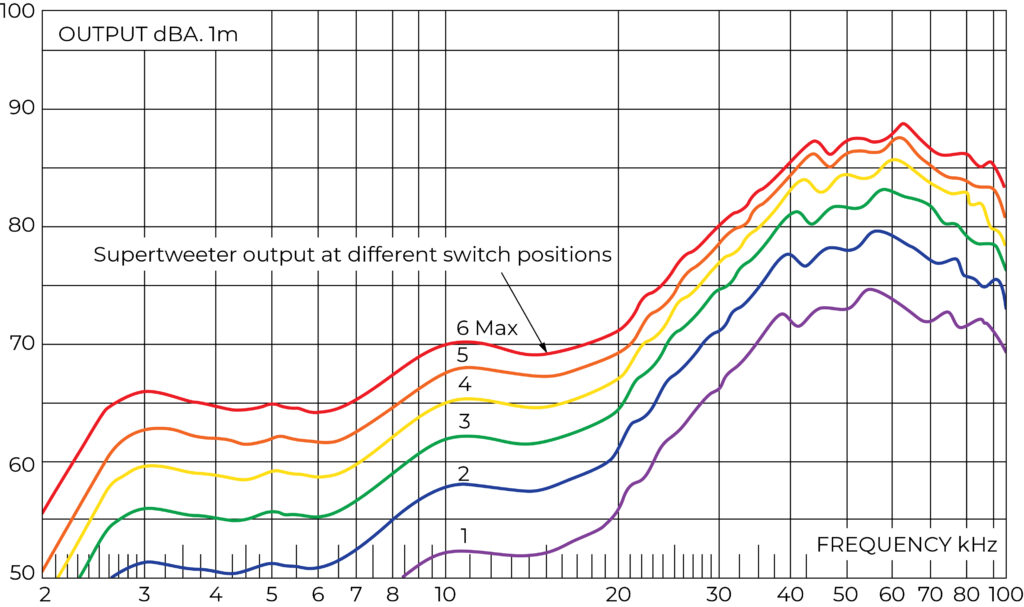
frequently asked questions
Yes, it does and the crossover allows the Supertweeter to have low output at about 10kHz and significant output from about 20kHz + filter in at approx.
Yes, on setting 5 or 6 the Supertweeter integrates surprisingly well with these >very high efficiency systems
The Supertweeter is connected directly across the amplifier terminals or across the tweeter terminals at your speaker. The standard connection is by way of piggy-back banana connectors.
Yes, on setting 5 or 6 the Supertweeter integrates surprisingly well with these very high efficiency systems
Yes, the Supertweeter comes with 1,5m standard Enhanced Deep Cryogenically Treated (EDCT) Litz multi-stranded separately insulated Litz Wire. Longer cable may be supplied to special order.
There is a special bracket for the Quad 57, as shown in the pictures. Please order when ordering Supertweeters
Most speakers employ dome tweeters which do show a frequency response up to and beyond 20kHz, but the response is very ragged below 20kHz due to the build-up of standing waves in the dome material. These standing waves take time to dissipate so keep sounding after the signal has passed. The resultant sound is slightly “tizzy” and can become irritating over time. The Supertweeter response, in contrast, is extremely fast with no resonant hangover, so when the Supertweeter is used in conjunction with the dome tweeter, the faster Supertweeter signal takes precedence over the slower signal. This ability of the ear to discern the faster signal (the precedence effect) on preference to the slower smeared signal causes the resultant sound to be far smoother but sharper then before. And yes, this is counter-intuitive, but it is so. Please study the frequency response graphs to see that the supertweeter response, although attenuated, extends below 20kHz (Response Supertweeter plus speaker, setting 4 above). This is sufficient for the precedence effect to come into play.
What our customers says about us?
4.9
Rating of 185 reviews
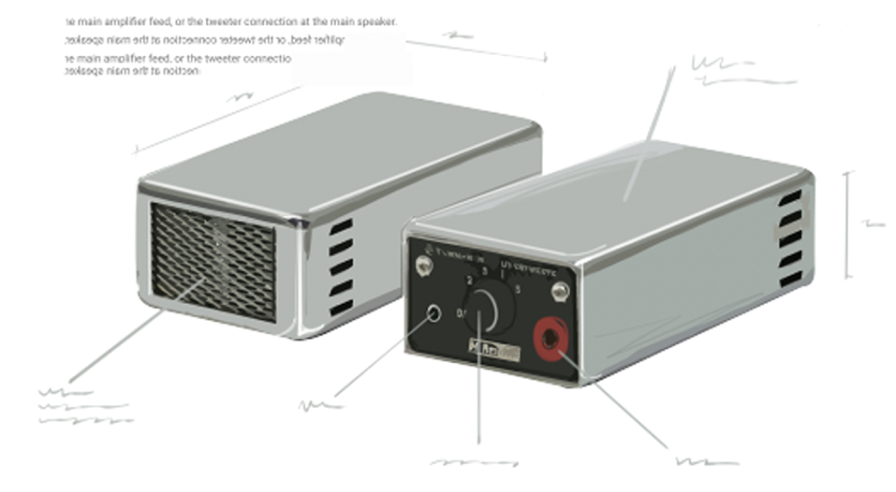
How The Supertweeter was born -Max Townshend
In the early seventies, I made a version of the HQD speaker system which comprised two Hartley 24” bass drivers, a pair of stacked Quad ESL-57s and a pair of Decca Ribbon speakers The Decca’s were used as supertweeters here to augment the treble roll-off associated with the ESL-57s. Inevitably, the ribbons got damaged and repairs were routine and I became adept at repairing them. This system sounded awesome and I was a sad chappie when I had to leave all behind in Sydney when I came to the UK in 1978.

Posted onTrustindex verifies that the original source of the review is Google. The analogy to my recent purchase of Townshend Seismic Podiums (Podia?) for my Wilson speakers relates to something that happened when I was in a pub in London with a colleague many years ago. We ordered a few Guinesses. I took mine, said Cheers and started drinking. My colleague waited a few minutes until the foam had died down, looked at the glass that was now about 85% full and said to the bartender "And the rest of it?" At which point his glass was topped off. The technical stuff is on their website, but I can tell you some of what I'm experiencing with the Seismic Podium 4's on my tube system. 1. First, a tiny rumble that would come on with the system, but before the music began was now gone. My guess is that some vibratory feedback between the speakers and system had been eliminated by the Seismic Podiums. I had always blamed my amp's tubes so I guess I owe them an apology. 2. As many others have pointed out in other places, there seems to be a touch less bass, but my impression is that that's just whatever smearing was going on being removed. The bass remains full, quick and detailed. 3. Mids - top end cleaner. Some top end smearing at high volumes was the reason I looked into speaker isolation in the first place and these did the trick in cleaning it up. If a recording is sibilant you'll still hear that. Well recorded music sounds better with some detail and nuance that was lacking in my case before - especially on more complex symphonic recordings and at higher volumes. I don't want to give the impression that the differences are only for loud music. I'm finding the music fuller and more enjoyable at low volumes as well. FWIW the other reason I bought these was that I didn't want to put spikes through a nice rug or damage my floor and I don't personally love dealing with little metal disks under 200+ lb speakers. Also, I sometimes like to shift the speakers around and that's difficult for me with spikes. Solved by putting some sliders under the feet of the Seismic Podiums. I like the flexibility to be able to put the Podiums on wood/carpet/cement... In terms of setup, it was pretty easy. I really like the leveling methodology which Townshend makes easy by just rotating the footer tops. (Counterclockwise to raise / Clockwise to lower). I will warn you that the first few hours listening are a little disorienting as you suddenly hear more everything in your music. I noticed better imaging and detail in particular. I think the soundstage is a bit deeper / wider but I have no plans to A-B that to confirm at this point. Your mileage may vary. Finally, the customer service was A+. John answered my many questions quickly, politely and helpfully. You tell him what speakers you have and he recommends which Podiums you need (1-5) and puts the right springs on before shipping. They were shipped quickly and arrived in perfect shape. So overall, my takeaway is that if you want the rest of it, either wait around in a pub in London or just get these things for your speakers.Posted onTrustindex verifies that the original source of the review is Google. World leading products and the best customer service I have experienced in 30 years of buying High End Audio equipment. After sales care is also the very best I have experienced. Very highly recommended products and customer relations I will definitely buy from Townshend family again!Posted onTrustindex verifies that the original source of the review is Google. Max Townshend's product designs are nothing short of remarkable and exemplary industry-defining achievements that set the bar. I use the Allegri control unit, the Fractal and Isolda analogue and digital interconnects and on a new loudspeaker system soon to be launched, the isolation pods. Every product makes a transformative improvement to sound quality and does so without recourse toward the ridiculous in pricing. I pray Max's legacy will continue, for I doubt there will ever be anything to match, let alone better what he has achieved.Posted onTrustindex verifies that the original source of the review is Google. Bought a Townshend Rock7 turntable several years ago. A fabulous sounding record player. Nothing I have previously owned or heard comes close.I have owned and heard some super decks. The Rock7 is at the top of the pile.Posted onTrustindex verifies that the original source of the review is Google. Great products, seismic podiums do give your speakers a big upgrade. I give 5 out of 5 stars because they deliver what they promise, highly recommended +++ kind regards to John from Egon
Why do they work when we can only hear up to about 15 kHz and the Maximum Supertweeters extend to 80 kHz? The standard test for frequency response is to play a pure tone sine wave and to ask the listener to indicate if they can hear it or not. This test is basically flawed since sine waves rarely if ever occur in nature. Extensive research has shown that it is the combination of the lower frequencies with the high frequencies that makes sound more realistic, just as a high resolution digital image looks clearer than a low resolution image because of the sharper delineation of the visual edges due to the higher amount of information in the hi-res image. So it is with audio. The ear is very sensitive to very fast transients and is able to detect very small time arrival differences between the two ears. This capacity evolved in the wild where it is essential to hear the slightest unnatural sound (breaking twig) when sleeping in the open. This capacity only diminishes slightly compared with normal frequency roll-off sensitivity to sine waves with age- related hearing loss.
Many normal sounds have frequencies extending way above 20 kHz, (see http://www.cco.caltech.edu/~boyk/spectra/spectra.htm), hence the popularity of high resolution audio in the form of Hi-Res downloads, SACD, DVD Audio and quality vinyl replay. The higher the bandwidth, even up to 100 kHz, makes a difference in the fidelity of the overall perceived sound. This can easily be proved experimentally. Latest research suggests that the very high frequency sounds are picked up by the temple and even the eye, where they are sent directly to the brain by neuron transfer, totally bypassing the ear.
Why do Supertweeters work on CD replay which extends only to 21 kHz, when the speakers extend to 20 kHz or beyond? The most common tweeter is the dome tweeter. The dome tweeter may measure well on sine waves, but, when playing music, less than 1% of the electrical energy sent to the tweeter is converted to sound, the rest being dissipated over a short time by rippling around the dome, while slowly converting to heat. The wave pattern of this dissipating sound is chaotic, not unlike the wave pattern in the sea on a rough day in an enclosed harbour. The Supertweeter however, which gently rises in output from about 12 kHz up, does not suffer from this problem as the ultra-light ribbon ceases moving almost instantly when the signal stops. This ensures a very accurate high frequency transient response where before there was smearing. An interesting property of the ear is that it responds to the fastest rise-time signal, from the supertweeter and ignores the jumbled time- smeared output from the dome tweeter. This is why it is unnecessary to attenuate the existing tweeter when adding the supertweeter.
How do they sound? The effect on the sound with the addition of the Supertweeters is quite unexpected. Bass notes sound clearer, especially plucked string bass. Everything in the sound stage appears cleaner and smoother with far greater width and depth. There is a sense of ease about the sound. The effect is most profound when the supertweeters are taken away. It is not subtle! A peculiar effect is that they are inaudible in the listening seat when the main speaker is disconnected. The ear works in mysterious ways! And there are many thousands of happy Supertweeter owners out there who will, agree.

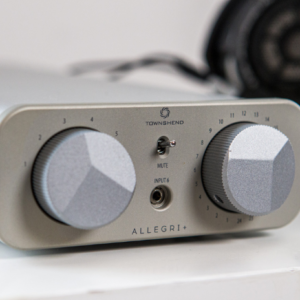
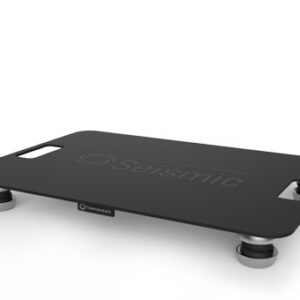
Reviews
There are no reviews yet.